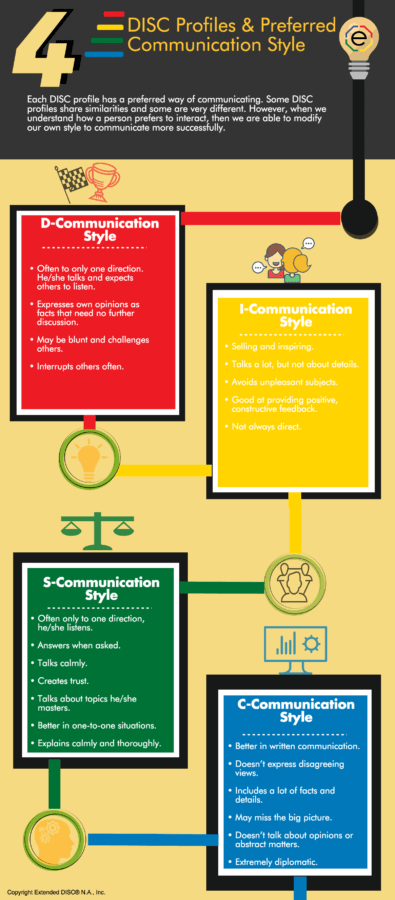Have you ever thought about how the 4 DISC types prefer to interact with you? If you can identify peoples' preferred DISC communication styles then you have an effective tool to better interact with them.
The 4 DISC types have preferred DISC communication styles. They have preferred ways in which they are more comfortable when interacting with others. Some DISC profiles share similarities and some are very different.

Are you communicating your information and ideas effectively?
Communication is about exchanging information and ideas with others. It can be easy, but it can also be challenging. We need to use all tools available to us to improve how we interact with others. One way is to use DISC. First, know that people communicate differently. Second, know that we have our own preferred DISC style. There's a good chance your DISC style will not be the same as others you interact with. Next, we need to identify the DISC style of others so that we know how that person prefers to interact. Finally, we modify our own DISC style to communicate more successfully. When we make these adjustments to our DISC style then we can better engage others. They will be more interested in what we have to say and we will most likely have a better outcome.
Preferred DISC communication styles of the D-Profiles
D-profiles often communicate in one direction. They talk and expect others to listen. D-profiles express their own opinions as fact; meaning their opinions need no further discussion. They may be blunt and they can often challenge others. Your interactions with the D-profile may feel like a competition. You will need to stand toe-to-toe. Since they want to move and complete tasks quickly, they may interrupt often and not ask for input from others.
If you want to interact more effectively with the D-profile then focus on tasks and results. Try keeping pace by moving quickly. Also, do not frustrate their desire to take action. They want to be in control so make them feel that they have power.
Preferred DISC communication styles of the I-Profiles
I-profiles communicate in an inspiring way. They will sell their ideas and visions. I-profiles will talk a lot. They prefer to look at the big picture and avoid details. I-profiles focus on the positive and tend to avoid unpleasant subjects. They are good at providing positive, constructive feedback, but they may not be direct.
When you are interacting with I-profiles, stay focused on the positive. Move quickly, but spend time chatting. Try to show interest when they are talking and talk about people over tasks. Try not to focus too much on details or focus on the negative.
Preferred DISC communication styles of the S-Profiles
The S-profiles, like the D-profiles, also prefer one directional communication. However, they prefer interactions in one-on-one settings. They answer when asked, but otherwise, they prefer listening to speaking. S-profiles tend to speak calmly and amiably. S-profiles look to create trust during the interaction. They prefer to talk about topics that they have mastered. In addition, they will explain things calmly and thoroughly.
Some tips for interacting successfully with the S-profile include slowing down and explaining in detail. Also, give them time to think and talk about it with others. Remember to warn them about any possible changes. Remember to focus on benefits to their team and people close to them. Last, but not least, focus on building trust.
Preferred DISC communication styles of the C-Profiles
C-profiles often prefer to use written communication, like emails. They don’t readily express disagreeing views. They want detailed, fact-based information to insure they make the correct decisions. Since C-profiles focus so much on details and data, they may miss the big picture. C-profiles prefer conversations where they don't have to focus on opinions or abstract matters. They can be extremely diplomatic.
Tips for improving interactions with C-profiles include giving them time to think and ask all of their questions. Then, when you are answering questions, make sure to explain carefully and give sound reasons and data whenever possible. Be patient with the details. Ideally, provide information in writing and ahead of time whenever possible.

Why modify your DISC profile to a person's communication style?
One tool to improve communication is to identify the person's DISC profile. Once you do that, you can make the most effective adjustments to your own DISC style. If you have information ahead of time for each of the 4 DISC types and how they prefer to communicate then you can make those changes much easier. If you are more aware and practice identifying and modifying, then you can become less frustrated with the different communication styles.
Please remember that DISC is not about asking you to change who you are; just consider making brief adjustments in the key moments in your interactions with others. In practice, this may be as simple as slowing down, talking more, or staying focused on the results. However, the end result will benefit both sides and truly maximize the exchange of ideas and information. Isn't that what communication is all about?
